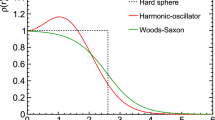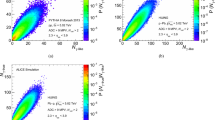Abstract
Heavy-ion collisions create a hot and dense matter called Quark-Gluon Plasma (QGP). Azimuthal anisotropy of produced particles is sensitive to the transport properties of QGP (the equation of state, speed of sound and specific shear viscosity) and may provide information about initial state of the collision. In this work, we report results for elliptic (\({{\upsilon }_{2}}\)) and triangular (\({{\upsilon }_{3}}\)) flow of charged and identified hadrons (\({{\pi }^{ \pm }},{{K}^{ \pm }},p,\bar {p}\)) in Au + Au collisions at \(\sqrt {{{s}_{{NN}}}} \) = 11.5, 14.5, 19.6, 27, 39, and 62.4 GeV from the STAR experiment at RHIC. Measurements of the collective flow coefficients \({{\upsilon }_{2}}\) and \({{\upsilon }_{3}}\) are presented as a function of particle transverse momentum (\({{p}_{{\text{T}}}}\)) and collision centrality. In addition the number of constituent quark scaling will be presented for these energies.




Similar content being viewed by others
REFERENCES
K. G. Wilson, “Confinement of quarks,” Phys. Rev. D 10, 2445–2459 (1974).
E. V. Shuryak, “Quark-gluon plasma and hadronic production of leptons, photons and psions,” Phys. Lett. B 78, 150 (1978).
L. Susskind, “Lattice models of quark confinement at high temperature,” Phys. Rev. D 20, 2610–2618 (1979).
M. M. Aggarwal et al. (STAR Collab.), “An experimental exploration of the QCD phase diagram: The search for the critical point and the onset of de-confinement,” arXiv:1007.2613 [nucl-ex].
S. Voloshin and Y. Zhang, “Flow study in relativistic nuclear collisions by Fourier expansion of azimuthal particle distributions,” Z. Phys. C 70, 665–671 (1996).
A. M. Poskanzer and S. A. Voloshin, “Methods for analyzing anisotropic flow in relativistic nuclear collisions,” Phys. Rev. C 58, 1671–1678 (1998).
J. E. Bernhard, J. S. Moreland, and S. A. Bass, “Bayesian estimation of the specific shear and bulk viscosity of quark-gluon plasma,” Nat. Phys. 15, 1113–1117 (2019).
P. Huovinen and P. Petreczky, “QCD equation of state and hadron resonance gas,” Nucl. Phys. A 837, 26–53 (2010). arXiv:0912.2541 [hep-ph].
L. Adamczyk et al. (STAR Collab.), “Azimuthal anisotropy in Cu + Au collisions at √s NN = 200 GeV,” Phys. Rev. C 98, 014915 (2018).
J. Adam et al. (ALICE Collab.), “Higher harmonic flow coefficients of identified hadrons in Pb–Pb collisions at √s NN = 2.76 TeV,” J. High Energy Phys. 09, 164 (2016). arXiv:1606.06057.
C. Gale, S. Jeon, B. Schenke, P. Tribedy, and R. Venugopalan, “Event-by-event anisotropic flow in heavy-ion collisions from combined Yang–Mills and viscous fluid dynamics,” Phys. Rev. Lett. 110, 012302 (2013).
L. Adamczyk et al. (STAR Collab.), “Elliptic flow of identified hadrons in Au + Au collisions at √s NN = 7.7–62.4 GeV,” Phys. Rev. C 88, 014902 (2013). arXiv: 1301.2348 [nucl-ex].
L. Adamczyk et al. (STAR Collab.), “Inclusive charged hadron elliptic flow in Au + Au collisions at √s NN = 7.7–39 GeV,” Phys. Rev. C 86, 054908 (2012). arXiv: 1206.5528 [nucl-ex].
I. Selyuzhenkov and S. Voloshin, “Effects of nonuniform acceptance in anisotropic flow measurements,” Phys. Rev. C 77, 034904 (2008). arXiv:0707.4672 [nucl-th].
S. A. Voloshin, A. M. Poskanzer, and R. Snellings, “Collective phenomena in non-central nuclear collisions,” Landolt-Bornstein 23, 293–333 (2010). arXiv: 0809.2949 [nucl-ex].
B. Alver and G. Roland, “Collision-geometry fluctuations and triangular flow in heavy-ion collisions,” Phys. Rev. C 81, 054905 (2010). arXiv:1003.0194 [nucl-th].
G. Torrieri, “Scaling of flow in heavy ion collisions and the low-energy frontier,” Eur. Phys. J. A 52, 249 (2016). arXiv:1512.04704.
C. Adler et al. (STAR Collab.), “Azimuthal anisotropy of \(K_{s}^{0}\) and Λ + Λ–-bar production at midrapidity from Au + Au collisions at √s NN = 130 GeV,” Phys. Rev. Lett. 89, 132301 (2002).
J. Adams, et al. (STAR Collab.), “Multistrange baryon elliptic flow in Au + Au collisions at √s NN = 200 GeV,” Phys. Rev. Lett. 95, 122301 (2005).
S. Afanasiev et al. (STAR Collab.), “Elliptic flow for mesons and (anti)deuterons in Au+Au collisions at √s NN = 200 GeV,” Phys. Rev. Lett. 99, 052301 (2007).
B. I. Abelev et al. (STAR Collab.), “Centrality dependence of charged hadron and strange hadron elliptic flow from √s NN = 200 GeV Au + Au collisions,” Phys. Rev. C 77, 054901 (2008).
Funding
The work was supported by the Ministry of Science and Higher Education of the Russian Federation, Project “Fundamental properties of elementary particles and cosmology” no. 0723-2020-0041.
Author information
Authors and Affiliations
Corresponding author
Ethics declarations
The author declares that he has no conflicts of interest.
Rights and permissions
About this article
Cite this article
Povarov, A. Scaling of Collective Flow of Charged and Identified Hadrons in Au + Au Collisions at \(\sqrt {{{s}_{{NN}}}} = 11.5 - 62.4 \) GeV from the STAR Experiment. Phys. Part. Nuclei 54, 619–623 (2023). https://doi.org/10.1134/S1063779623040263
Received:
Revised:
Accepted:
Published:
Issue Date:
DOI: https://doi.org/10.1134/S1063779623040263




